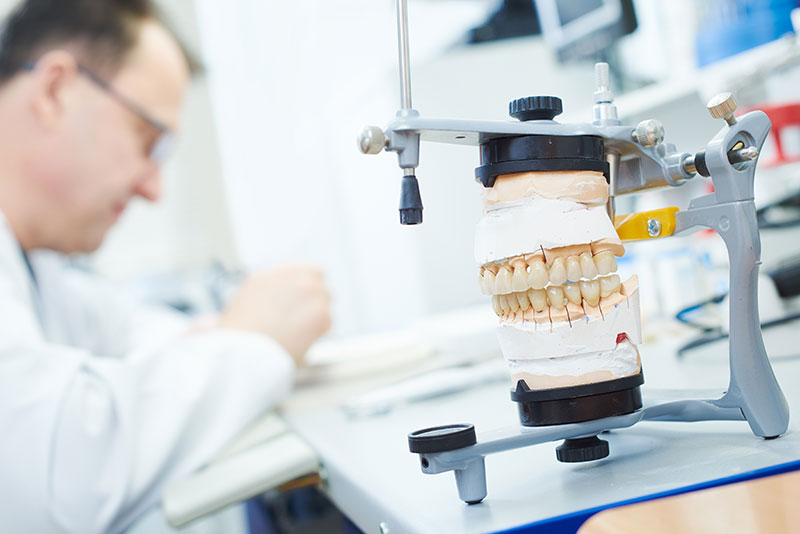What’s a Dental Bridge?
Tooth loss is extremely common and can occur for a number of reasons. Perhaps you’ve had an accident that has knocked a tooth out, or you may have severe decay or gum disease that has led to you losing a tooth or needing an extraction. Whatever the reason, tooth loss can affect the function and appearance of your teeth. Dental bridges are one of the most effective ways of restoring your smile.
What are Dental Bridges?
Dental bridges are a popular restoration tool for replacing missing teeth. As their name suggests, they quite literally bridge the gap where a tooth has fallen out or has been extracted. The basic design of a dental bridge is a false tooth that replaces the missing tooth which is supported by a crown on either side. These crowns sit over the top of healthy teeth on either side of the gap and secures the bridge in place.
Who Needs Dental Bridges?
Dental bridges can be successfully used to restore the teeth for patients in a wide range of different situations. You may need a dental bridge if:
- You are missing between one and four consecutive teeth on the same side of your mouth or at the front of your mouth.
- Your tooth loss is the result of severe decay or trauma to the tooth.
- The function of your teeth is adversely affected— meaning that you can’t bite or chew your food as normal — or your missing teeth are affecting your speech.
- Other tooth replacement solutions aren’t suitable for you. For example, you may not be a candidate for a dental implant.
Types of Dental Bridges
While most dental bridges share similarities in their design, there are several types available. This enables you to pick the bridge that best suits your individual needs.
Traditional Bridges
A traditional dental bridge is the most common type of bridge. Traditional bridges have one or more artificial teeth called pontics. They are held in position by crowns placed over the teeth on either side of the gap. These are known as abutment teeth and will then always require crowns even if you later choose a different type of dental bridge.
Cantilever Bridges
Cantilever bridges are used when the patient only has healthy supporting teeth on one side of the gap — for example, at the back of the mouth. Since the bridge can only be supported on one side, it is generally less stable than traditional bridges.
Maryland Bridges
Also known as a front dental bridge, Maryland bridges are used to replace missing teeth at the front of the mouth. Unlike traditional bridges, they aren’t held in place by crowns. Instead, metal or porcelain bands are used to secure the artificial tooth to the back of the adjacent natural teeth.
Composite Bridges
In composite bridges, a combination of composite resin and nylon strips are placed into the gap between the teeth and are used to create the artificial tooth which is sculpted by hand. The cost of composite bridges is less than other varieties, but since they aren’t as secure, they are often thought of as a temporary dental bridge.
Implant-Supported Bridges
This innovative type of bridge uses the dental implant technique to support it. The crowns are secured onto implant posts that have been surgically placed into the jawbone rather than onto your natural teeth. Also known as a dental implant bridge, it’s considered stronger and more secure than alternatives. However, it is only suitable for patients with enough healthy bone in their jaw to support it.
Dental Bridge Procedure
Exactly what will happen during your dental bridge procedure will vary slightly depending on the type of bridge that you are having. This will be discussed with you during your consultation. Typically, you can expect the process to take place in a number of steps:
- If you are having crowns placed over the abutment teeth, you’ll need to have these prepared. This involves the removal of some of the enamel covering them so that the crowns fit properly.
- Impressions will be taken of your teeth. These will be used to create your bridge which will be made in the perfect shape and size to fit into the available space.
- A temporary bridge will be placed over the abutment teeth to protect them while your permanent bridge is being created.
- Finally, you’ll return to have your temporary restoration removed, your permanent bridge checked for fit and then secured into place.
It’s important to be aware that the process of getting an implant-supported bridge is different. At the first stage, you will need to have your implants surgically placed and given time to heal.
Pre-Treatment Care
Your dentist will want to make sure that your teeth and mouth are healthy before you undergo a dental bridge procedure. A robust oral hygiene routine at home and professional dental clean with your dentist before your procedure are strongly recommended. You’ll be given a local anesthetic before each appointment which will ensure that you aren’t in pain while the work is carried out.
Post-Treatment Care
It is normal for a dental bridge to feel a little unusual at first, but most patients adjust to their permanent bridge within a few weeks. Once your bridge is in place, you will need to continue to take good care of your oral health by brushing and flossing each day and visiting your dentist regularly. You’ll also need to prevent damage to your bridge by avoiding chewing hard foods and objects.
Certified Oral Surgeons
A dental restoration is only as good as the oral surgeon who carries out the treatment. This is particularly true for an implant-supported bridge which require an invasive surgical procedure to place it. Look for a board-certified oral surgeon who has plenty of experience and the reviews to back it up. They should be willing to answer your questions and share dental bridge before and after pictures to illustrate their work.
Same Day Appointments Available
If you would like to find out more about dental bridges, we have a number of same day appointments [SS2] available. These can be used to answer any questions that you have and discuss your suitability for this treatment.
Monthly Payment Options That Work for Your Budget
We understand that not everyone has dental insurance that will cover the cost of a dental bridge, particularly if you are having an implant-supported bridge. We are delighted to offer monthly payment options that can work for your budget, helping you to get the quality of care that you deserve.
We offer a variety of payment options to make your crown affordable. We also accept most dental insurance plans and have a dental discount program for patients without insurance. Call us at our toll-free number 888-329-8111 or make an appointment online here.




